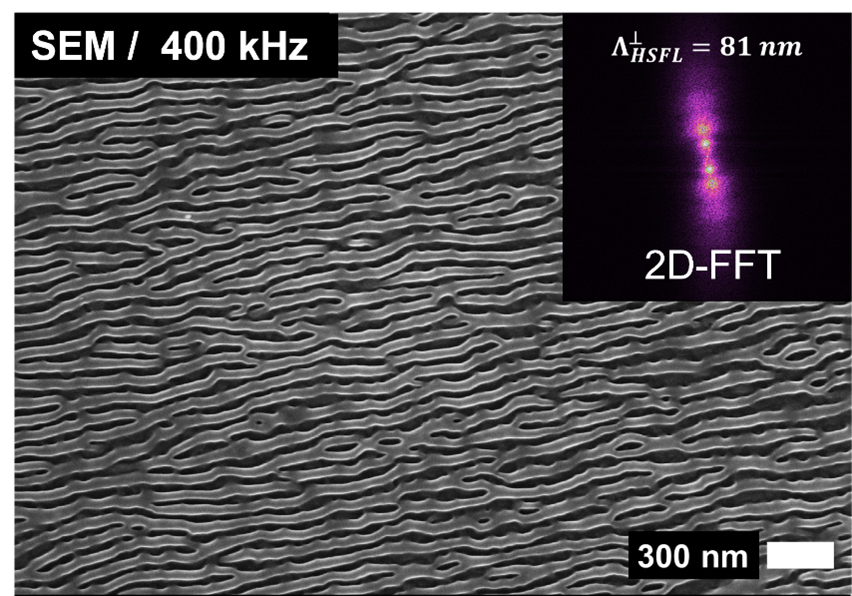
Sub-100 nm HSFL nanostructures on titanium alloy generated by ps-laser pulse repetition rates of 400 kHz.
Source: BAM, Division Surface Analysis and Interfacial Chemistry
As part of an EU-funded research project (LaserImplant), the surface chemistry and topography of a laser-nanostructured titanium implant material was investigated with regard to the suitability and scalability of the processing method for an industrial process. The results were presented at the last Spring Meeting of the European Materials Research Society in the symposium "Making light matter: lasers in material sciences and photonics" and were recently published in the journal Physica Status Solidi A.
Ultrashort pulsed laser radiation offers the special possibility of generating "self-organized" periodic surface structures with sub-wavelength spatial periods far below the optical diffraction limit (so-called HSFL: High Spatial Frequency Laser-Induced Periodic Surface Structures). Titanium alloys are particularly suitable for this purpose and offer a wide range of potential applications in medicine.
The publication describes morphological, topographical and chemical surface changes (e.g. oxidation) induced by ps-laser processing of Ti-6Al-4V alloys in air. A multi-method approach was used, including scanning electron and atomic force microscopy, tactile profilometry, time-of-flight secondary ion mass spectrometry (ToF-SIMS) with depth profiling, and hard X-ray photoelectron spectroscopy (HAXPES). The study focuses on how the number of laser processing passes or the laser pulse repetition rate affects HSFL and whether its potential scaling meets industrial requirements.
The study shows that it is possible to increase the processing speed of HSFL nanostructures on titanium materials via the ps-laser pulse repetition rate up to 400 kHz in an industrially suitable manner avoiding limiting heat accumulation effects. The HSFL nanostructures are accompanied by a graded near-surface oxidation (from Ti2O3 to TiO2) over depths of a few tens of nanometers.
Chemical and topographical changes upon sub-100-nm laser-induced periodic surface structure formation on titanium alloy: the influence of laser pulse repetition rate and number of over-scans
Kai Müller, Francesca Mirabella, Xenia Knigge, Marek Mezera, Matthias Weise, Mario Sahre, Karsten Wasmuth, Heike Voss, Andreas Hertwig, Jörg Krüger, Jörg Radnik, Vasile-Dan Hodoroaba, Jörn Bonse
published in Physica Status Solidi A, 2023, essay number: 2300719, pages 1 bis 12
BAM Department Materials Chemistry
BAM Division Surface Analysis and Interfacial Chemistry
BAM Division Material and Surface Technologies


